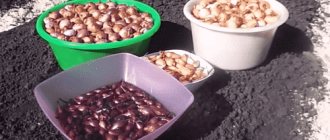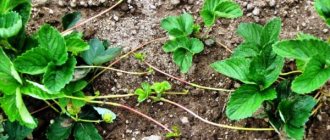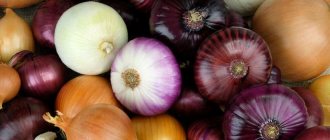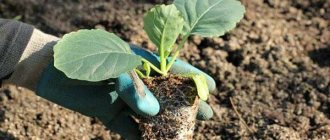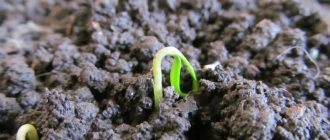Description and varieties of crops
Shallots are similar to onions; planting and care in open ground are the same. It also has an onion taste and aroma, but it is softer and not as spicy.
Shallot has other names. It is popularly called Ashkelon onion, family onion, kushchevka, charlotte, shallot, bush onion and old believer onion.
Unlike ordinary onions, one shallot plant forms from 4 to 18 bulbs, connected to each other by one bottom. Typically, the weight of the bulbs varies from 20 to 50 g, but the root crops of hybrid varieties can reach 90 g.
The shape of the bulbs is elongated, teardrop-shaped. Often there are several lobes inside each of them. The average size of each root vegetable is 6 cm.
Shallots are bright green, with thin walls, and a characteristic aroma. It is juicy, without any sharpness. One plant produces up to 10 feathers ranging from 20 to 50 cm in length.
The color, ripening time, size and shape of shallots largely depend on the variety. The list contains the most popular options:
- "Banana delicacy" It is distinguished by large bulbs of an elongated curved shape. The weight of each of them varies from 48 to 80 g. The root vegetables have an average density, their flesh is white with a reddish tint, and the husk is red-violet. The taste is sweet. The variety is mid-season, heat-resistant, frost-resistant. There is immunity to rot.
- "Prince". Dense elliptical bulbs reach 25 g. The husk is dark, red-brown. The succulent layers have a light purple color. The taste is sweet and spicy. The variety is mid-season.
- "Emerald". It has round bulbs weighing 18–22 g. The husk is brownish-pink in color, the flesh is creamy with a slight green tint. The taste is spicy-sweet. The pulp is not watery, but juicy. The variety is early ripening.
- "Centipede." The bulbs are drop-shaped, elongated, reaching 10 g in length. Weight varies from 25 to 75 g. The peel is golden-orange, the inner layers are white with a lilac tint. The taste is sweet and spicy. One outlet produces from 6 to 20 pcs. The variety is early ripening.
- "Pomegranate". Early ripening variety. Drop-shaped, round-oval shape. The husk is red, and the juicy layers are pinkish. The taste is sweet. Head weight 20–40 g.
- "Olivia". The bulbs have an elliptical shape. Dry layers are pinkish-orange, juicy layers are white with a pink tint. The weight of each bulb reaches 26 g. The variety is early ripening.
Shallots are grown all over the world. It grows equally well in Krasnodar, Sochi, Moscow, Siberia and the Astrakhan region.
Shallot breeding methods
Shallots are grown in a variety of ways. The method is chosen taking into account what part of the plant the gardener wants to collect and how quickly:
- Growing from sets. Sets are called miniature bulbs. They are sown in spring or autumn. In one season, large onions are obtained, ready for harvest.
- Seed cultivation. In the first year, this method allows you to obtain greens and seedlings for planting. Only a year after planting will the gardener be able to collect the formed shallot bulbs.
- Seedling method. If you sow shallot seeds as seedlings, you will be able to harvest large bulbs at the end of summer. To get seedlings by the end of spring, they are sown in early April.
Harvest
It is important to harvest on time, otherwise there is a possibility that the bulbs may germinate. Shallot nests are removed from the ground when most of their feathers have dried out. After removing the onions from the soil, dry them in the shade. After this, the dried leaves are carefully removed, and the nests are disassembled into bulbs. The harvest is placed in a box, net or box and stored in a cool, dark place where there is no high humidity.
Sometimes experienced summer residents do not trim dry feathers, but weave braids from them. In this way, you can extend the shelf life of onions, but do not forget to regularly check for rotten onions. This method will make it possible to preserve the product for 5 to 7 months.
Sometimes shallots are stored peeled, but this option can only be achieved by freezing the vegetable. You can store its feathers in the same way; it is recommended to chop the onion before freezing. Do not be afraid that after freezing shallots will lose their beneficial qualities - frozen onions will retain vitamins and important elements.
Growing shallots is not difficult, the main thing is to follow all the recommendations and fertilize on time. Do not forget about regular checking for the presence of insect pests, because the earlier the disease is detected, the more vegetables can be saved.
Preparing shallots for planting
To grow shallots, it is important to create optimal conditions for their growth. Preparatory work is carried out in advance. Not only the seed material is prepared, but also the soil.
When to plant
The timing of planting shallots is determined not only by the region, but also by the time when the gardener wants to get the harvest. Planting material is sown in early spring or late autumn.
Planting onions before winter is used only in southern regions, such as Belgorod, Crimea, Sochi, Krasnodar, and Astrakhan region. Planting material is sown at the end of October or beginning of November. In order for the onion to take root, at least 3 weeks must pass from planting to frost.
Shallots are a cold-resistant crop. Onions are sown already in the first half of April.
Experienced gardeners advise taking into account the indications of the lunar calendar.
Favorable days for planting shallots in 2022:
| Month | Favorable dates | Unfavorable dates |
| March | 8, 10, 16–19 | 9, 20–21, 24 |
| April | 5–7, 9–15, 17–22, 27–30 | 8, 14–16, 23 |
| May | 2–6, 9, 11–12, 20–21, 29–31 | 7, 13–14, 22 |
| June | 7–9, 11–14 | 5, 8–10, 22 |
| July | 4, 6, 9–11, 13–16, 27–29 | 5, 7–8, 20 |
| August | 5–10 | 3–4, 19, 31 |
| September | 24–26 | 1–2, 17, 27–28 |
| October | 3–6, 8–11, 13–15, 18–23, 26–28 | 2, 16, 22–25 |
| November | 5–9, 22–24 | 15, 20–22, 30 |
Days not listed in the table are also suitable for planting. During this period, the Moon does not have a significant effect on the bow.
To view a complete overview of growing onions in practice:
Place and soil for planting
For shallots, choose the most sunlit, open areas of the garden. No other representatives of the Onion family should grow in the chosen location for the past three years.
The best precursors for shallots are legumes, nightshade, pumpkin, cabbage, and cruciferous crops. It is useful to plant them next to each other. This will increase protection against diseases and pests.
Shallots love loose, nutritious neutral soil. If the acidity of the soil is increased, add ash or dry lime.
The site is prepared at least 3 weeks before planting. It is dug up, cleared of weeds, and fertilizers are applied at the rate of 6 kg of humus, 20 g of potassium salts, 30 g of superphosphate per 1 sq. m. m.
Fertilizers are mixed with the soil, dug again, then leveled with a rake. 2–3 days before planting onions, water the soil with a hot solution of copper sulfate (1 tablespoon of the product per bucket of water) at the rate of 10 liters of the product per 1 square meter. m.
Seed preparation
To protect shallots from infection, as well as to increase the germination of planting material, preparatory work is carried out before planting.
How to properly prepare shallots for planting:
- Calibration The bulbs are sorted, removing all damaged, rotten and stained specimens. The finer the planting material, the longer it will take to germinate.
- Disinfection. The seedlings are immersed in a light pink solution of potassium permanganate or “Fitosporin” for 10 minutes.
- Growth stimulation. Planting material is soaked for 2–3 hours in a growth stimulator, for example, Epin.
If seeds are not used for planting, they are germinated in advance. To do this, planting material is disinfected, soaked in a growth stimulator, and then wrapped in a damp cloth, placed in any container and placed in a warm place.
In addition, read how to treat onions before planting.
Answers to frequently asked questions
Which variety of heirloom onion should I choose?
In general, there are special varieties for Siberia, but shallots grow quickly and can be grown from seeds without problems. So take the variety you like.
Which bow is better? Family or onion?
It is impossible to answer this question unequivocally. Both vegetables are healthy and used in cooking. For example, turnips are more suitable for marinades and preparing meat for barbecue, while shallots go well with other vegetables and do not interrupt the taste of the main product.
The best solution to this issue would be to sow both varieties.
What are the features of growing shallots?
In general, none. Just one small detail. In spring, Ashkelon onions should be sown as soon as the snow melts.
Is it possible to collect nigella from onions in the garden?
Quite. Perhaps some qualities of the new plants will not be the same as those of the parent specimens, but can you get a harvest from nigella?
How often should fertilizing be done?
1-2 is enough. In the spring, before planting the seeds and in the summer, during the growing season. Apply organic matter the first time, and nitrogen fertilizers the second time.
How often should heirloom onions be watered?
In a good summer, once every 1-2 weeks. But during a drought, every 2-3 days. If the summer, on the contrary, is rainy, then do not forget to loosen the soil so that the water does not stagnate and rotting does not begin.
Is it possible to plant shallots next to onions?
It is undesirable to do this, as there is a high probability of cross-pollination. What does it mean? You will not get what you planted the family for: delicate taste, absence of unpleasant odor, productivity. It is better to separate the family and turnips by other crops.
How to choose a day to plant shallots?
Focus on the lunar calendar. Plant on the waning moon and under no circumstances work on the days of the full moon or new moon.
How to Plant Shallots
The technique for planting shallots depends on the type of planting material and the time of work.
Sowing sets:
- Make grooves about 5 cm deep. The distance between the grooves should be 10–15 cm.
- The bulbs are laid bottom down in the furrows. The distance between them depends on the size. For planting material with a diameter greater than 4 cm, a distance of 20 to 30 cm is maintained, bulbs measuring 3 cm are sown at a distance of 15–20 cm from each other, smaller sets are sown at a distance of 8–10 cm.
- In the spring, the seedlings are sprinkled with earth so that at least one third of it protrudes above the soil surface. During winter planting, the bulbs are completely covered.
- The beds are watered with water at room temperature and covered with mulch (humus, peat, sawdust, rotted hay or straw).
For early harvest of feathers, large shallot bulbs are planted in the fall. To obtain root crops, sets are sown in early spring, choosing not very large planting material.
If the sets are sown only to obtain feathers, it is not necessary to maintain the specified distance between the bulbs. When growing herbs in a pot on a windowsill, shallots are often planted back to back.
Seeds are sown in grooves 1 cm deep, with a distance of 10 cm between them. To make the planting material easier to see, the bottom of the groove is sprinkled with sand or chalk. The seeds are placed in the hole at a distance of 3–5 cm from each other. Then they are covered with soil, watered and mulched.
After the emergence of seedlings, the plantings are thinned out. Spaces of at least 8 cm are maintained between plants.
Video about planting bulbous crops:
Harvest and storage
From mid-July you need to start cutting the feathers, otherwise during harvesting you can cause active growth of splinters and the development of green feathers in them. The harvest itself must be harvested at the end of July. The signal for this will be the drying and yellowing of most of the leaves, since this process is accompanied by the death of the roots at the bottom.
Ripe bulbs need to be dug up with a shovel and carefully pulled out of the ground, and then shaken off and dried in the sun for 20-30 days. In cloudy weather, onion fruits removed from the soil should be removed to a shaded place for drying for several days.
Dried leaves need to be cut off, leaving only a thin neck 3-5 cm high. Next, the dry heads need to be disassembled into bulbs. They can be stored in boxes, drawers or nets, put away in a dry and cool place. The vegetable can be stored in this form for 5-7 to 12 months. In this case, the bulbs need to be regularly inspected, promptly removing rotten specimens.
The extracted bulbs can also be stored frozen. This is done in the following order:
- Peel the onions.
- Cut large heads into pieces.
- Moisten the bulbs a little and place in the freezer to freeze.
- Transfer the frozen product into a plastic container and put it back in the freezer for storage.
Using the same technology, you can freeze shallots. With this storage, the vegetable retains all its beneficial properties.
You can see how shallots are harvested in the video below:
Plant care
Shallots are a hardy plant. To get a rich harvest, it needs to be properly cared for. It involves regular watering, weeding, fertilizing, prevention of infections and harmful insects.
Watering
Shallots are watered as the top layer of soil dries out, on average 3-4 times a week. Use warm, settled water. Watering is carried out early in the morning or in the evening.
3 weeks before harvesting root crops, the frequency of watering is gradually reduced. This will make the taste of shallots richer and increase shelf life.
A day after each watering and precipitation, the soil is loosened. When loosening, the beds are cleared of weeds.
Top dressing
If the soil for planting shallots has been prepared correctly, then only 2 feedings will be needed per season. Use the following scheme:
- The nutritional composition is first introduced after the third feather is thrown out. Use a mixture prepared from 10 liters of water, 1 tbsp. l. urea, 0.5 tsp. potassium nitrate.
- The shallots are fed a second time after the formation of the 5th feather. A solution prepared from 10 liters of water and 1 tbsp is added to the soil. l. "Monopotassium phosphate."
A short video about crop care:
How to properly care
In order for the plant to grow strong, healthy, and most importantly, with excellent external and taste qualities, it is recommended to take good care of the shallot bulbs. To do this, it is worth watering, loosening and weeding, as well as promptly applying fertilizers to the family onions.
Watering, loosening and weeding
Watering the shallot plantings during the first time after sowing should be carried out frequently, in sufficiently large volumes. When harvesting is planned, 21-28 days before it begins, it would be correct to slowly reduce the application of nutrient moisture. This is necessary so that the feathers have time to acquire a yellow tone and dry completely.
It is necessary to periodically loosen and weed between the bulbs so that the plant receives a sufficient amount of oxygen necessary for development. Such an event is also necessary to ensure that a dense crust does not form on the surface, which does not allow moisture to flow evenly to the plants. Periodic loosening should also be carried out in order to eliminate fast-growing weeds that clog useful plantings.
Fertilizer application
During one growing season, shallots are usually fed 2 times.
The first application of fertilizers is carried out in the spring, when the first 3 feathers appear on the plant. , urea or urea is used as shallot feeding , diluting 1 tbsp. for 1 bucket of water. To this consistency it is recommended to add an additional 1/2 tbsp. l. potassium fertilizer .
The second application of fertilizing for the family onion is carried out when the 5th feather appears. During this period, the plant vitally needs phosphorus and potassium . To do this, use potassium monophosphate in a volume of 1 tsp. for 1 bucket of water.
Diseases and pests of onions
Shallots are susceptible to certain fungal infections. They often attack plants in rainy, cool weather. If signs of the disease are detected, infected plants are removed, and healthy ones are treated with Fitosporin.
Shallot diseases:
- Powdery mildew. Spots and stains appear on the feathers, reminiscent of whitewash.
- Powdery downy mildew (peronosporosis). The feathers are covered with light green spots, which turn yellow, and in wet weather they acquire a gray-violet hue.
- Fusarium wilt. The greenery turns yellow, withers, and a pinkish coating forms on it. When examining the bulbs of affected plants, a rotting bottom is discovered.
- Cervical rot. The green part of the plant withers and dries up. The bulbs rot layer by layer, emitting an unpleasant odor.
Shallots are sometimes attacked by pests. This usually happens when the plants are in the wrong proximity.
Onion pests:
- aphid;
- onion fly;
- onion nematode.
